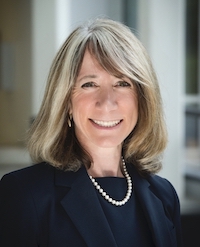Since the start of the coronavirus pandemic, the National Science Foundation has awarded more than 800 Rapid Response Research (RAPID) grants designed to get researchers into the field and lab quicker than the traditional grant process. George Mason University researchers have received seven of these grants so far.
“Mason's faculty have quickly pivoted to use their incredible expertise to address the COVID-19 pandemic,” said Aurali Dade, associate vice president for research and innovation at Mason. “There are currently more than 40 active COVID-19 projects led by Mason faculty. These NSF Rapid awards highlight some of the very important contributions Mason's research community is making to respond to the pandemic.”
An Ensemble Approach to Combine Predictions from COVID-19 Simulations
Taylor Anderson
Taylor Anderson, an assistant professor in the Department of Geography and Geoinformation Science, is working with College of Science colleagues, Hamdi Kavak and Andreas Züfle, to develop an interactive web-based dashboard that will serve as an open and accessible tool to inform the public, fellow researchers, and decision-makers where existing COVID-19 models agree and disagree on predictions.
The project will be broken into two phases. The first will align the models and collect data on their predicted number of COVID-19 infections and fatalities over a period of time. Next, the team will use data mining to find clusters among the model predictions, indicating agreement.
Taylor and colleagues received almost $200,000 for this work.
Developing Pandemic and Healing Models to Assist in Policy Making

Sai Dinakarrao
Sai Dinakarrao, an assistant professor in the Department of Electrical and Computer Engineering (ECE), is working with other researchers to develop a software tool he hopes will help confine the COVID-19 pandemic and future epidemics.
Working with researchers from the University of California, Davis, and Morgan State University in Baltimore, Dinakarrao is looking at such factors as population density, demographics, climate and transportation statistics, which could help determine strategies that would prevent surges in the virus without taking a huge toll on the economy.
Dinakarrao believes it is imperative to understand how to minimize the spread of the epidemic while also minimizing deleterious effects and maximizing the availability of critical health resources. His ultimate goal is to create solutions that will help communities navigate even worse scenarios than what society has seen during the COVID-19 pandemic.
Dinakarrao received $40,000 for this work.
A Portal to Support Models for Assessing Strategies for Hospitals in the COVID-19 and Other Pandemics

Elise Miller-Hooks
Bill and Eleanor Hazel Chair in Infrastructure Engineering Elise Miller-Hooks and her team are collaborating with Mersedeh Tariverdi, a senior data scientist in the Health, Nutrition, and Population Group at the World Bank, to launch a web portal that will support models that aid hospital responses to the pandemic.
The team’s work supports evidence-based decision making, informed by the models, to rethink and facilitate hospital operations when using limited critical resources as demand surges. While working as a PhD student under Miller-Hooks’ supervision, Tariverdi developed key models that now serve as the backbone for the MASH-Pandemics portal.
Miller-Hooks and colleagues received $200,000 for this work.
Networked Compartmental Modeling and Analysis for Spread of COVID-19

Cameron Nowzari
Cameron Nowzari, an assistant professor in the Department of Electrical and Computer Engineering, and his collaborators are developing numerical methods and mathematical models to provide complementary support to the epidemiologists worldwide who are working to understand how COVID-19 spreads.
The models developed will expand beyond the simple Susceptible-Infected-Removed (SIR) models to capture a number of different properties specific to COVID-19 by adding more compartments. These models will provide a more rigorous analysis of the network effects of the ongoing pandemic, which may prove especially useful as different parts of the country, or even the world, are imposing/lifting various levels of mobility restrictions at different times.
Some of the questions they hope to answer are: Is social distancing working? How much more effective would it be to require people to shelter-in-place? Is it worth the social cost? What is the effect of 10% of the population ignoring these protocols? What is the marginal benefit of enforcing quarantines versus implementation cost?
As they work, the researchers expect that their questions will evolve.
Nowzari received $150,000 for this work.
Examining the Use of Big Data Analytics to Enhance Response to COVID-19 Pandemic

Hemant Purohit
Hemant Purohit, an assistant professor in the Department of Information Sciences and Technology, and his research team are sifting through millions of tweets to gain insight into people’s response to COVID-19 in the Washington, D.C., metropolitan area.
They are using a tool, called CitizenHelper, to help sort through tweets to identify behaviors that could assist emergency agencies and give them an understanding of the population’s attitudes. It uses artificial intelligence (AI) techniques to filter the posts and then determine the relevance and information level of each tweet. The tool was developed as part of a larger research project Purohit is working on, which was also funded by NSF.
Purohit has teamed up with Steve Peterson from Montgomery County, Maryland’s Community Emergency Response Team (CERT), which is spearheading this initiative and bringing it to other areas of the region, including Fairfax County’s CERT.
Purohit received $24,266 for this work.
Studying COVID-19 Spread in Aircraft Cabin Setting
_0.jpg)
Padmanabhan Seshaiyer
Mathematical sciences professor Padmanabhan Seshaiyer, associate dean of academic affairs in the College of Science, is serving as a principal investigator on a collaborative proposal with Maziar Raissi of the University of Colorado at Boulder, in which they are developing a computational methodology that can predict the spread of COVID-19 in an airplane cabin.
The computational methods Seshaiyer and Raissi develop will lead to a high-performance computing software, which will allow the researchers to model, analyze, predict and present control mechanisms for a COVID-19 outbreak through a spatial and temporal distribution of airborne infection risk in an aircraft cabin using computational mathematics and modern physics-informed deep learning techniques.
The proposed work might also be extended to apply to other physical spaces, such as marine vessels, trains, buses, or other public transport.
Seshaiyer received $59,999 for this project.
Building a Spatiotemporal Platform for Rapid Response to COVID-19

Chaowei Yang
Chaowei Yang, director of the NSF Spatiotemporal Innovation Center at Mason and a professor in the Department of Geography and Geoinformation Science, is building a spatiotemporal platform to support rapid response to COVID-19. This project is a collaboration with the Center for Geographical Analysis at Harvard University.
Yang and his collaborators are building and enriching a comprehensive data repository of virus cases and associated social and natural information from different resources, such as authoritative reports, news releases, Earth observation, and social media, to create a sustainable archive.
Yang’s team is using spatiotemporal tools developed in the center and integrating them into easy-to-use workflows to assist researchers, in collaboration with public health experts, to identify case trajectories, rebuild traces, and forecast future trends, for reproducible and replicable research. They are also conducting spatiotemporal analyses to mine for patterns and relationships in the social and natural factors for community response and preparedness.
Yang received $99,956 for this project.
